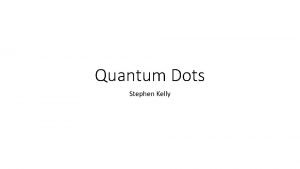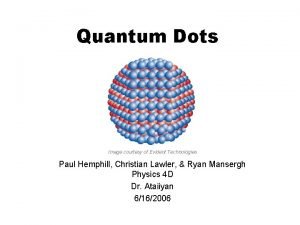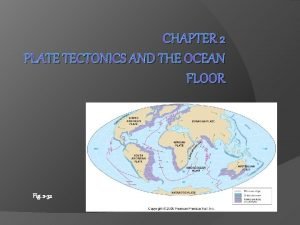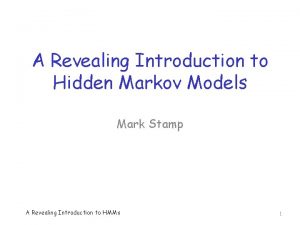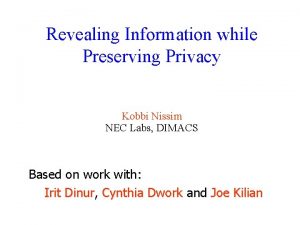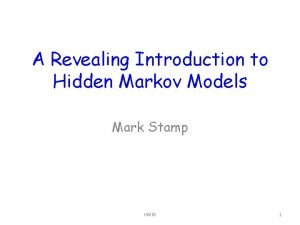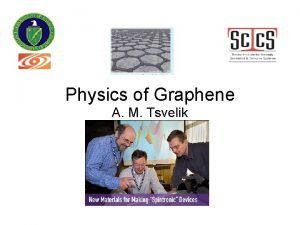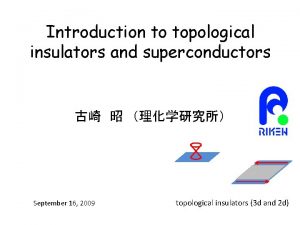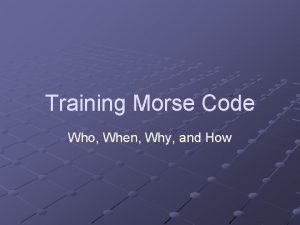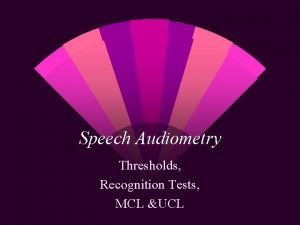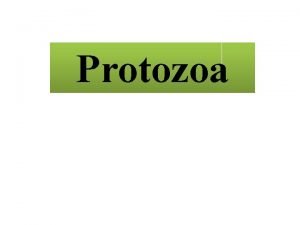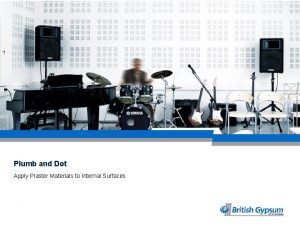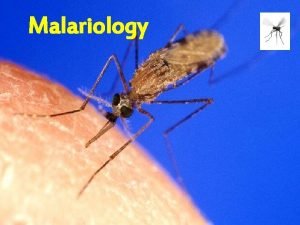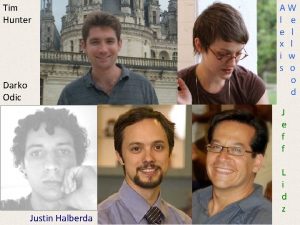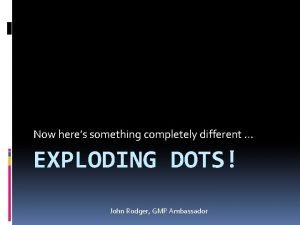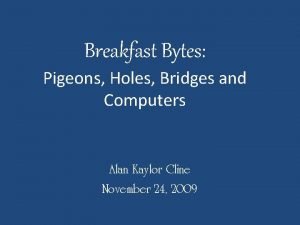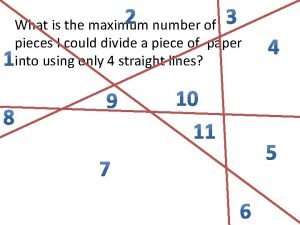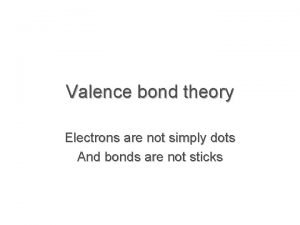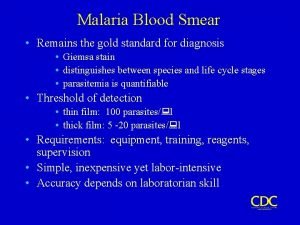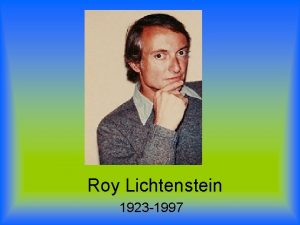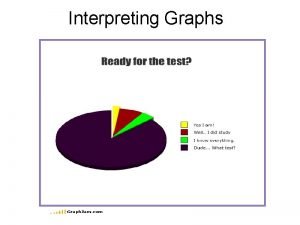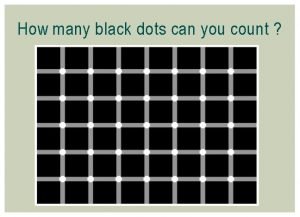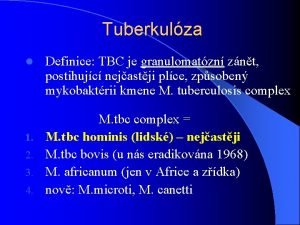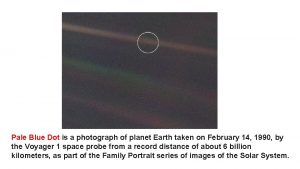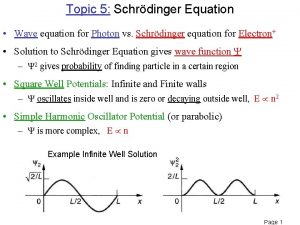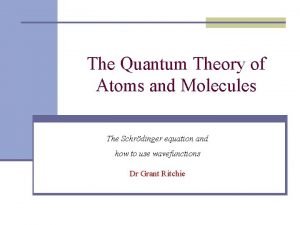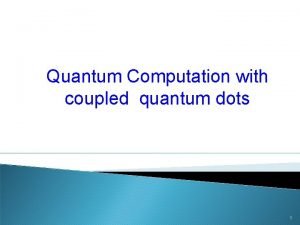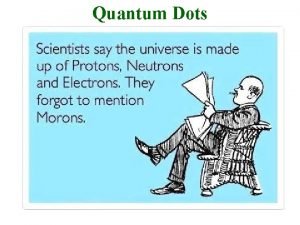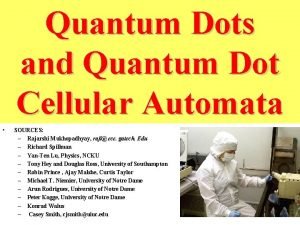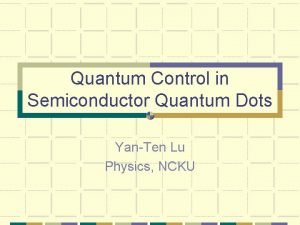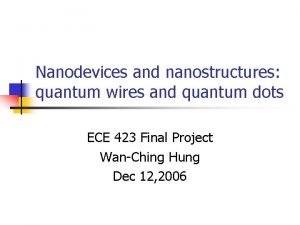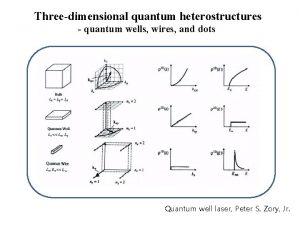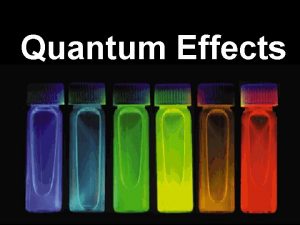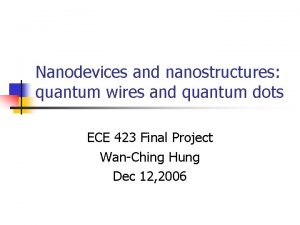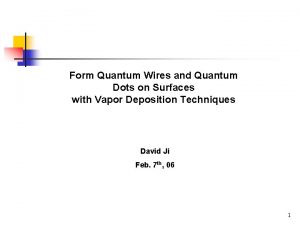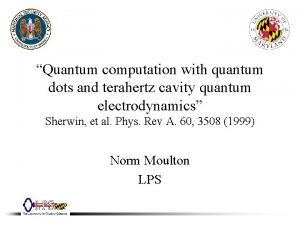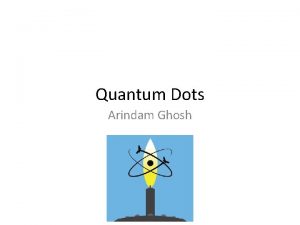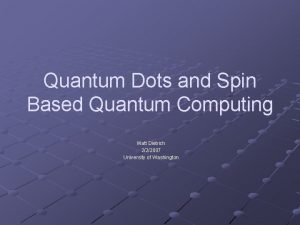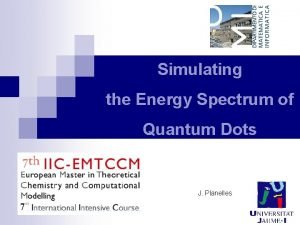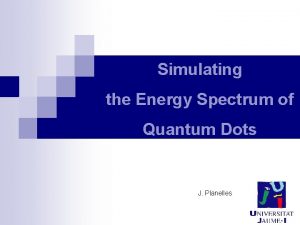Revealing Energy Level Structure of Individual Quantum Dots

















































- Slides: 49

Revealing Energy Level Structure of Individual Quantum Dots by Single-Electron Sensitive Electrostatic Force Spectroscopy Peter Grütter, FRSC Y. Miyahara, A. Roy-Gobeil L. Cockins, A. Clerk Mc. Gill University Montreal (Canada) www. physics. mcgill. ca/~peter P. Grutter

Outline/aim 1. Introduction 2. How to measure electron energy levels 3. How to determine shell structure of qdot 4. Summary & conclusion

Coulomb Blockade Rings

Coulomb blockade energy e 2/C




Experimental configuration Charge sensing by oscillating AFM tip (frequency mode AFM) Tip is a moveable gate Force detection by AFM (tip act as an electrometer) Single barrier tunneling (to/from sample ONLY) PNAS 107, 9496 (2010)

back ç electrode

back electrode





Cockins et al. , PNAS 107, 9496 (2010) Note: clean decoupling of conservative and dissipative forces is necessary! Labuda et al. , PRB 84, 125433 (2011) OR optical excitation


P. Grutter, Mc. Gill University

Non-Degenerate Energy Levels Using Linear Response Theory: Coupling Strength dissipation Tunneling Rate Res. Freq. E Fermi Function

T=4. 2 K a=0. 25 nm a= 0. 04 (DE=e a. VB) EC= 29. 5 me. V DE=11 me. V Cockins et al. , PNAS 107, 9496 (2010)

How can we measure the shell structure?

Temperature-dependent shifts of Coulomb blockade peaks predicted for degenerate single particle levels by Beenakker, Phys Rev B 44, 1646 (1991) Cockins et al. , PNAS 107, 9496 (2010)

Large oscillation amplitude spectra: strong coupling regime Bennett et al. , Phys. Rev. Lett. 104, 017203 (2010)


Drive amplitude changes coupling strength! Peaks 1 (a) and 2 (b) Peaks 3 -6: Exp (c) and Theory (d) Experiment (solid) Theory (dashed) Shell-filling can be determined by skewed peaks Bennett et al. , Phys. Rev. Lett. 104, 017203 (2010)

How can we measure the shell structure? 1. T- dependence of peak position [weak coupling regime] 2. Line shape (asymmetry) [strong coupling regime] 3. Energy dependence of tunneling rate How can one measure the tunneling rate?

Lets look at weak coupling regime a bit more in detail Due to the finite tunneling rate of electrons, the probability of having an extra electron on the dot at time t, <P(t)>, is out of phase with respect to the cantilever motion <z>. This results in a back-action force that changes both the force sensors resonance frequency, w and its dissipation, g , with magnitudes: (in weak coupling regime)

10, 8, 6, 4 continuous density of states with r=1 ΔE/k. B T single non-degenerate level energy level spacing Tunneling rate G= Gon + Goff depend on DOS(dot) 0 k. BT What does G(E) look like?

Tunneling rate measurements on In. As qdots Shell structure and fill factors can directly be determined by measuring G(E) Nano Lett. 15, 2324 (2015) Degenerate states: Two-fold degenerate level: Red: shell filling n=0 Green: shell filling n=1 Four-fold degenerate level: Orange: n = 0

Engineering tunneling barrier is crucial Line shapes (weak coupling, single non-degenerate level): Experimentally, in order to achieve sufficient signal to-noise, it is ideal to operate in a regime where the cantilever's response is evenly split between w and g. This condition is met when the ratio between the effective tunneling rate G between the dot and the back electrode matches the mechanical resonance frequency w of the cantilever.

DOS of 5 nm Au particle (77 K) C 11 alkane thiol barrier EC = 16 me. V C 11 alkane thiol barrier Template stripped ultra flat gold C 11 alkane thiol barrier 5 nm Au particles, measured at 77 K Nano Lett. 15, 2324 (2015)

DOS of 5 nm Au particle (77 K) EC = 16 me. V Tunneling rate data (blue) superimposed with a fit to the analytical expression for a continuous density of states (dashed line) Nano Lett. 15, 2324 (2015)

Engineering tunneling barriers: 6 ML Na. Cl on Fe(001) Bias spectroscopy above a 3 nm Au dot @ RT in UHV Measured EC = 137 me. V. Au particle must be truncated sphere (FE model) Truncated sphere Nanotechnology 23, 505602 (2012)

What information can be extracted quantitatively? 1. Coulomb blockade energy 2. Eigen state energy (energy levels) 3. Shell structure 4. Excited state energies

Excited State Spectroscopy Increase in dissipation occurs when the electron can tunnel into a higher shell. s-shell peak: D D Nano Lett. 12, 709 (2012) Phys. Rev. Lett. 104, 017203 (2010)

What information can be extracted quantitatively? 1. 2. 3. 4. Coulomb blockade energy Eigen state energy (energy levels) Shell structure Excited state energies 5. Stability diagrams (coupling between dots) 1. Capacitive coupling (‘weak’ coupling) 2. Tunneling coupling (‘strong’ coupling)

Stability diagrams via imaging a) Topography b) Frequency Shift c) Dissipation 6 5 4 3 2 1

Imaging mode: spatial axis (x, y, z) = energy axis Imaged at fixed z. 20 nm Scanning changes the lever arm (or voltage divider) a -8. 0 V -9. 0 V +6. 8 V -8. 0 V

Imaging Coupled Quantum dots: stability diagram 20 nm Test if lever arm a is linear, then Convert spatial axis to energy axis

Coupled quantum dots Coherent or correlated? Example of 3 coupled QDs: 20 nm Weaker coupling 20 nm Stronger coupling


t n e m e in f on e t o N e th c f o y t i ls! b ia tia r va ten e po g lar

Effect of environment on confinement potential In. As structure appears to contain one QD. While scanning suddenly we observe 2 QDs! 20 nm Scan dir’n -8. 0 V -9. 0 V +6. 8 V -8. 0 V

Summary: what can one measure/learn? • Coulomb blockade energy • Eigen state energy levels & excitation energy via Amplitude shape (strong coupling regime), Peak position as f(Temperature) or Energy dependence of tunneling rate • Coupling between dots (Coulomb and tunneling) ‘Images’ can be converted to stability diagrams (without gates!) • Coherent interdot tunneling coupling and double-dot T 1 Weak coupling tip-qdot (=linear response) measures dynamic response of charge in dots, allowing T 1 to be extracted; this is NOT the same physics as in QPC measurements. The oscillating tip-field modulates the barrier between dots. The tip also measures the response to this modulation (back-action), which contains all of the quantum mechanical dynamics.

Summary: method AFM tip serves as an electrostatic gate and a charge sensor fm-AFM technique – key is low frequency dependent phase noise to cleanly measure dissipation Qdot - sample tunneling barrier needs to be engineered: ~resonant frequency of cantilever Interpretation of line shapes: quantum back action of single electron tunneling on sensor Review: Nanotechnology 28, 064001 (2017)


Dr. Yoichi Miyahara, Romain Stomp Lynda Cockins Antoine Roy-Gobeil Prof. Aashish Clerk

Take home messages: Substantial surface potential variations on semiconductor surfaces(>100 m. V , 50 nm lateral scale). Depends on processing conditions, affects transport properties and mobility. EFM allows full characterization of energy levels of individual and coupled quantum dots, including dynamics. Physics is back action of quantum system (single electron) on cantilever. Tuning fork based AFM systems (‘q. Plus’) less sensitive, but can still be used as SGM to obtain intriguing results.

Can one measure spins? P. Grutter

What information can be extracted quantitatively? 1. 2. 3. 4. Coulomb blockade energy Eigen state energy (energy levels) Shell structure Excited state energies 5. Stability diagrams (coupling between dots) 1. Capacitive coupling (‘weak’ coupling) 2. Tunneling coupling (‘strong’ coupling) 6. Power spectrum of electrical noise of environment, spatial localization of 2 level fluctuators. 7. Coherence time 8. Reorganization energies
 History of quantum dots
History of quantum dots Evident technologies
Evident technologies Origin of quantum mechanics
Origin of quantum mechanics Quantum physics vs mechanics
Quantum physics vs mechanics The ocean floor revealing plate tectonics
The ocean floor revealing plate tectonics A revealing introduction to hidden markov models
A revealing introduction to hidden markov models Tru face revealing gel
Tru face revealing gel Revealing information while preserving privacy
Revealing information while preserving privacy A revealing introduction to hidden markov models
A revealing introduction to hidden markov models Order revealing encryption
Order revealing encryption Landau level quantum hall effect
Landau level quantum hall effect Landau level quantum hall effect
Landau level quantum hall effect Energy energy transfer and general energy analysis
Energy energy transfer and general energy analysis Energy energy transfer and general energy analysis
Energy energy transfer and general energy analysis Oaaa oxxx xxxx xxxx morse code
Oaaa oxxx xxxx xxxx morse code Mcl and ucl
Mcl and ucl Schuffner dots malaria
Schuffner dots malaria Which artist utilized benday dots in his artwork
Which artist utilized benday dots in his artwork Dots in plastering
Dots in plastering Maurer dots
Maurer dots Fixing into thermalite blocks
Fixing into thermalite blocks Trantas dots
Trantas dots Pharmacy dots initiative
Pharmacy dots initiative Think dots differentiated instruction
Think dots differentiated instruction Think dots differentiated instruction
Think dots differentiated instruction K3p lewis structure
K3p lewis structure Darko hunter
Darko hunter Dippin dots franquicia
Dippin dots franquicia Exploding dots.org
Exploding dots.org Lesson 31 connect the dots lewis
Lesson 31 connect the dots lewis Connect all dots without crossing the lines
Connect all dots without crossing the lines Clear the blue dots
Clear the blue dots Connect 9 dots with 4 straight lines
Connect 9 dots with 4 straight lines Dot sp
Dot sp Ben day dots art
Ben day dots art Dot
Dot Think dots
Think dots Roy lichtenstein (1923-1997)
Roy lichtenstein (1923-1997) Dots expansion
Dots expansion Patah tebu
Patah tebu What do the dots represent
What do the dots represent Black dots
Black dots Dots tb
Dots tb Dots tbc
Dots tbc Two blue dots one planet
Two blue dots one planet What is a tire rotation
What is a tire rotation Adobe illustrator pop art
Adobe illustrator pop art 99 dots
99 dots Expectation value of energy in quantum mechanics
Expectation value of energy in quantum mechanics Expectation value of energy in quantum mechanics
Expectation value of energy in quantum mechanics
